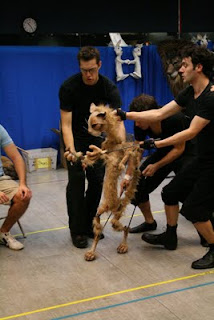Contributed by guest blogger of the week, James Comtois.
I realize I didn't completely answer the question I (or really RLewis) posed in the last entry. I guess I didn't because I didn't want to make the entry all about Yours Truly. But since this is my final blog post on this site, I guess I can make this entry a little more about myself as a means of attempting to answer: who do you make theatre for?
The short answer: about 60% for myself, 40% for the audience.
The medium answer: It started out for myself, but there was a brief time during my company's history where I was unable to answer that question at all. Currently, it's very important that the show pleases me, and that it's very much worth the audience's time, attention and money.
Now for the slightly longer answer, which will require a somewhat insider baseball story about my company and how we tackled a situation that forced us to confront this issue.
Last year, we had planned to stage our annual anthology show of original horror plays (The Blood Brothers present... series). We tentatively landed on a space and dates (I write "tentatively" because we had yet to put any money down). We were all gearing up to make this our October production.
However, the venue got overbooked, and our tentative run and tech time got considerably truncated (basically down to a long weekend with one night of tech). The remaining dates were still available to us, but we had to make a decision, and fast: do we stage the show with limited tech time and a substantially limited run, or do we go, "Screw it, it ain't worth it?"
Our immediate, knee-jerk reaction was to put it up anyway. That shoot first, ask questions later mindset, I think, is one of the reasons why my company's lasted for so long: put on a show, no matter what, don't worry about the limitations, just go, go, go.
But for the first time, we actually reconsidered moving forward with that mindset. It would be a minuscule run, we'd have no prep time, and some of us at Nosedive Central felt that it just wasn’t worth it.
Since at this time we were a 10-year-old company, we no longer had that feeling that we Had Something To Prove (keep in mind that this debate for an October show or not was taking place in August, just one month after we had closed our most expensive production to-date, and had barely any liquid assets left at our disposal). We had staged 20 productions in 10 years—we could begin to consider ourselves a Real Theatre Company.
Why were we fighting so hard? What were we trying to prove?
Who were we doing this for?
We really didn't have an answer.
Ultimately, we opted out. We decided it wasn't worth doing it solely for the sake of doing a show/filling a slot in our season. And really, if we had decided to forge on through, that's what that show would have been—a time-filler; a show solely put on for the sake of satisfying an obsessive-compulsion.
Plus, it would have been a very rushed, half-assed production.
Hey, I'll admit it: when you produce theatre for a certain period of time, you can have a tendency to run on autopilot (especially if you find yourself doing multiple projects at once and find yourself in a rhythm of nearly constant theatre-related activity). And I for one do not want to be running on autopilot anymore.
I definitely want to continue writing and producing often—and, as another bit of inside baseball, it looks as though I will be, as apparently Nosedive's going to be staging three shows in three months this summer—and work hard in ensuring that whatever I write and stage will be better than the show before it.
But I no longer have interest in putting on a show just for the sake of putting on a show (the theatrical equivalent of marking notches on the bedpost). I want there to be a good reason. I want to be excited to present whatever Nosedive's presenting to a potential audience.
I want the productions to matter.
Otherwise I don't see much point. Otherwise it's too damn time-consuming and too damn expensive, for both me and audience members.
So, what are we to take away from these blog entries, if we're to take anything away? I guess my motif seems to be a seemingly contradictory blend of suggesting to work often, work fast, and work better, but only if you really care about what you're doing.
Or maybe really caring about what you're doing will enable you to work often, faster and better.
Or maybe working often, faster and better will force you to figure out what you really care about.
Or, heck. Maybe Homer Simpson was right. Maybe there is no moral. "It's just a bunch of stuff that happened."
I dunno. You make up your own mind. And your own model for making theatre.
And on that note, that just about does it for me on this site. I'd like to thank Shay Gines and the rest of the crew at the IT Awards for letting me blather cybernetically on their blog. It's been quite fun for me. I hope you've enjoyed yourself, too.
Catch y'all later.
Exeunting like he's being pursued by a bear,
James "The Timothy Treadwell of Theatre" Comtois












